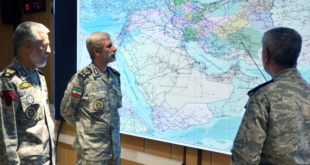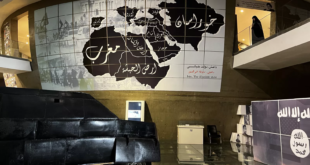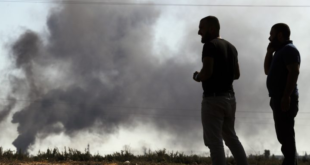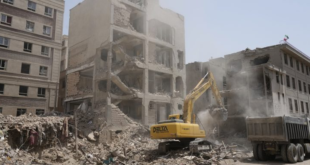OCCUPIED JERUSALEM — The cranes and bulldozers building a barrier to suicide bombers in this disputed city are also raising barricades to the Palestinian dream of a contiguous state with East Jerusalem as its capital.
Israel says security needs have forced it to build 80 kilometres of eight-metre-high concrete walls and electric fences around Jerusalem.
But the route strays from Jerusalem’s municipal borders and slices through Arab neighbourhoods. That feeds Palestinian suspicions that Israel is hiding behind security arguments to increase Jerusalem’s Jewish population at the expense of Arab residents, cement its hegemony over the city, and prejudice a final peace deal.
Ibrahim Ghosheh fears the half-completed barrier will separate his home from his restaurant in the Beit Hanina neighbourhood of the city. Already, he said, his customers have dropped to a trickle.
“We need peace. We want peace. But the (Israeli) government is just making hate,†he said.
Slogans scrawled on the barrier sum up the conflict.
“Israel lives on stolen land,†reads one piece of graffiti in English. “Kahane was right,†counters another, in Hebrew, referring to Rabbi Meir Kahane, a slain Jewish extremist who advocated expelling Arabs from Israel.
The Jerusalem enclosure is part of the 680-kilometre-long barrier Israel has been building for more than two years to separate itself from the West Bank.
Its loop around Maaleh Adumim, Israel’s largest settlement, with 30,000 people, would cut off East Jerusalem, the Palestinians’ most potent symbol, from its West Bank hinterland.
“They (Israelis) want to sever the head from the body, they want to cut off Jerusalem from Palestine,†said Palestinian Prime Minister Ahmed Qureia.
To address Palestinian concerns that the barrier route will cut off the northern West Bank from the south, Israel is considering connecting the two halves with a road outside the barrier.
Israeli Vice Premier Ehud Olmert, a former mayor of Jerusalem, said the planned route is clearly about security, not politics. “We are not moving the fence for enjoyment or our pleasure,†he said, “but because there are security concerns of the highest level.†During the past 4 years of violence, 22 suicide bombings killed 170 people in Jerusalem.
Raanan Gissin, an aide to Prime Minister Ariel Sharon, estimates the route puts 50,000 Palestinian Jerusalemites outside the barrier. Palestinian cartographer Khalil Tufakji puts the number at at least 100,000 — or nearly half the city’s Arabs. “Israel wants to keep as few Palestinians as possible in Jerusalem, and at the same time, have the highest possible number of Israelis in the city,†Tufakji said.
Haim Ramon, Israel’s Cabinet minister for Jerusalem, says the barrier route “makes Jerusalem more secure.†“It also makes it more Jewish,†Ramon said. “The safer and more Jewish Jerusalem will be, the more it can serve as a true capital of the state of Israel.†Designated by the United Nations in 1947 as an international city, Jerusalem ended up split into Jewish and Arab halves. Israel captured the Arab half in the 1967 war, declared Jerusalem united under its sovereignty, and extended its municipal boundaries into parts of the surrounding West Bank.
Today about one-third of the city’s 700,000 people are Arabs in East Jerusalem, an Arab commercial, religious and social hub.
The barrier slices out six Palestinian neighbourhoods that lie within Jerusalem’s municipal boundaries. It also walls out tens of thousands of other Palestinians who hold Jerusalem residency papers but live in nearby West Bank homes where housing is much cheaper.
Israel plans to build a network of crossings and roads to organise traffic between the two sides.
But critics say the problem is not traffic but the disruption of many religious, social and economic ties between East Jerusalem and the West Bank.
Abu Dis is an Arab neighbourhood that straddles Jerusalem and the West Bank. The road that once ran to the West Bank town of Jericho through Abu Dis now stops dead in front of a concrete wall.
About three-fourths of the neighbourhood’s 40,000 residents now live outside the wall, estimates Amos Gil, executive director of Ir Amim, a Jerusalem-based group led by Israelis who oppose the barrier’s route. A building once meant to serve as the Palestinian parliament peeks over the barrier on the West Bank side.
Abu Dis residents managed to cross through breaks in the wall, often unimpeded. On a recent day, two border policemen stood chatting near a gateway fronted by concertina wire that has become a makeshift crossing. They barely looked at Palestinians crawling through a gap.
“From Warsaw Ghetto to Abu Dis Ghetto,†said English-language graffiti on the barrier. “Make Love, Not Walls.†Israel’s talk of alternative arrangements is “ridiculous,†said Mohammed Dahi, a lawyer who argues Palestinian challenges to the barrier route in Israel’s supreme court.
“It doesn’t solve the problem,†Dahi said. “The problem here is that people who used to live all these years in Jerusalem, and for whom Jerusalem is the centre of their life, will be out of Jerusalem day and night.â€
 Eurasia Press & News
Eurasia Press & News



